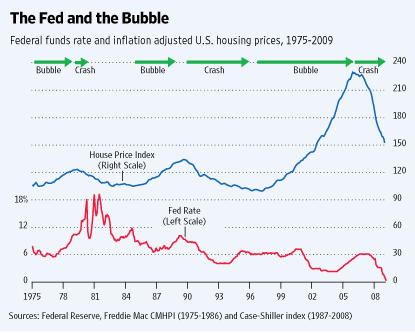Very interesting column in the WSJ yesterday on Bubble economics by Steven Gjerstad and Nobel Laurelate Vernon Smith. (Longtime BP readers may recognize Vernon Smith’s name from this somewhat amusing incident).
They dissect the housing and credit bubbles, and how they fell apart.
My favorite part is their discussion of how absurd OER measurements are when it comes to identifying inflation in Housing:
“In 1983, the Bureau of Labor Statistics began to use rental equivalence for homeowner-occupied units instead of direct home-ownership costs. Between 1983 and 1996, the price-to-rental ratio increased from 19.0 to 20.2, so the change had little effect on measured inflation: The CPI underestimated inflation by about 0.1 percentage point per year during this period. Between 1999 and 2006, the price-to-rent ratio shot up from 20.8 to 32.3.
With home price increases out of the CPI and the price-to-rent ratio rapidly increasing, an important component of inflation remained outside the index. In 2004 alone, the price-rent ratio increased 12.3%. Inflation for that year was underestimated by 2.9 percentage points (since “owners’ equivalent rent” is about 23% of the CPI). If home-ownership costs were included in the CPI, inflation would have been 6.2% instead of 3.3%.
With nominal interest rates around 6% and inflation around 6%, the real interest rate was near zero, so household borrowing took off. As measured by the Case-Shiller 10 city index, the accumulated inflation in home-ownership costs between January 1999 and June 2006 was 151%, but the CPI measured a mere 23% increase. As the Federal Reserve monitored inflation in the early part of this decade, home-price increases were no longer visible in the CPI, so the lax monetary policy continued. Even after the Fed began to slowly raise the fed-funds rate in May 2004, the average rate remained low and the bubble continued to inflate for two more years.”
Good stuff.
One caveat: I was surprised to read some fuzzy thinking and unsupported assumptions in the piece, but the one that struck me in particular was this: “Both the Clinton and Bush administrations aggressively pursued the goal of expanding homeownership, so credit standards eroded.”
Its a giant non-sequitor. There is no explanation of how the political goal of increased home ownership led to the business decisions by loan originators and banks to decrease lending standards.
Other than that, its a thought provoking read . . .
>
Previously:
A funny thing happened to me on the way to the studio tonight . . . (November 1st, 2003)
http://www.ritholtz.com/blog/2003/11/a-funny-thing-happened-to-me-on-the-way-to-the-studio-tonight/
Source:
From Bubble to Depression?
STEVEN GJERSTAD and VERNON L. SMITH
WSJ, APRIL 6, 2009
http://online.wsj.com/article/SB123897612802791281.html



What's been said:
Discussions found on the web: